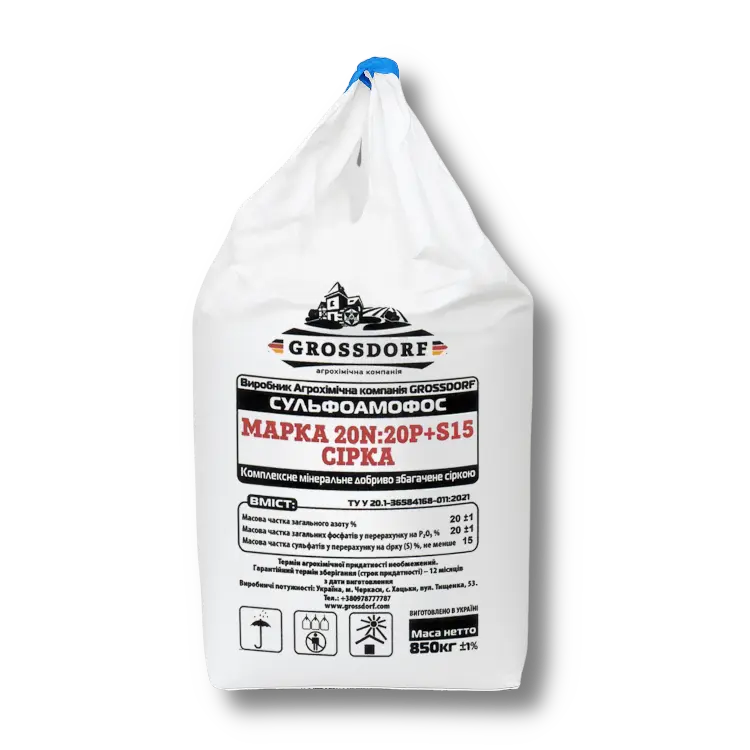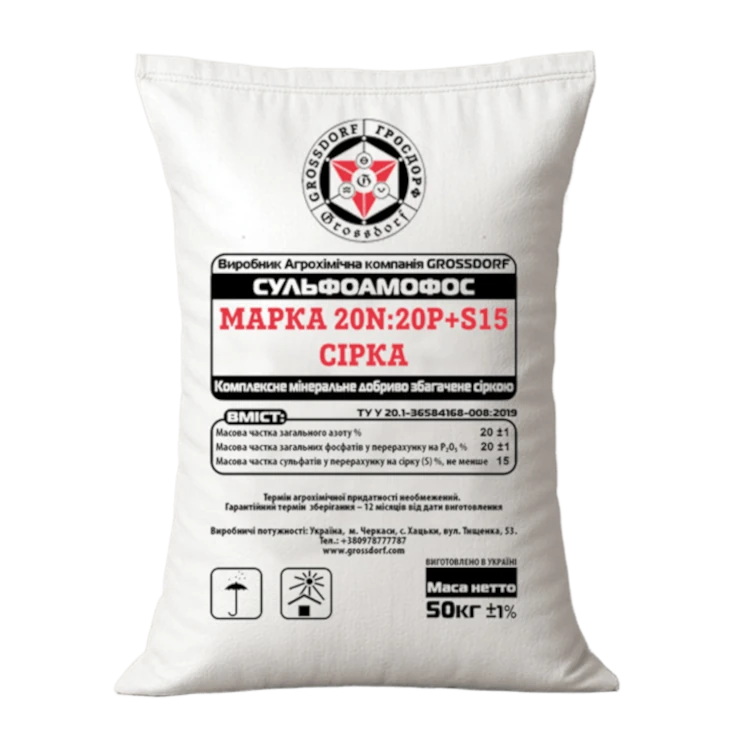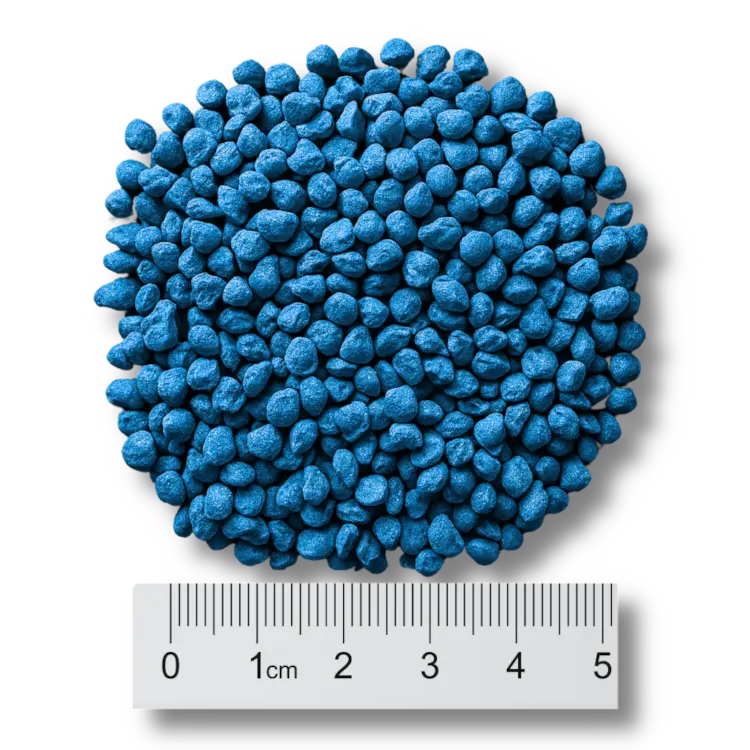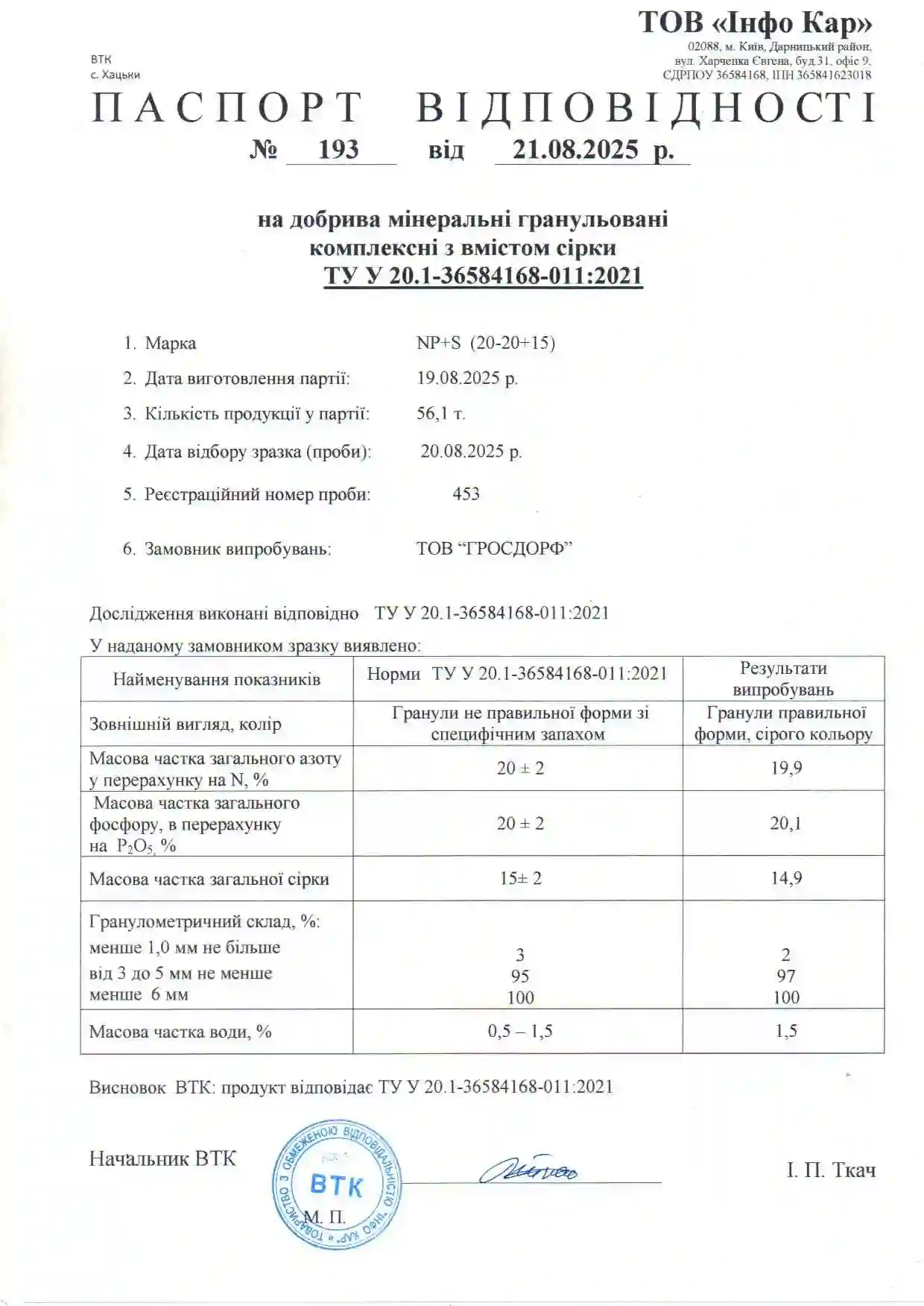Sulfoammophos N20:P20+15S
Mineral granular complex fertilizer
with sulfur content “NP+S 20:20+15”
TU U 20.1-36584168-011:2021
Terms of sale/packaging: EXW, FCA, big bag, 50 kg bag
Delivery terms: by own transport on the territory of Ukraine or self-delivery
Khatsky, Cherkasy region | Mayaky, Vinnytsia region | Poltava | Ternopil |
|---|---|---|---|
28 400 | 28 400 | 28 400 | 28 400 |
General characteristics
Sulphoammophos N20:P20+15S is a concentrated nitrogen-phosphorus fertilizer with a high sulfur content in the form of sulfate (SO₃), which is readily available to plants. This combination is especially beneficial for crops with elevated needs for nitrogen, phosphorus, and sulfur, such as rapeseed, cereals, corn, legumes, oilseeds, and vegetables. The N:P ratio of 1:1 makes this fertilizer ideal for starter applications, when plants require balanced nutrient intake to support root development, photosynthesis, and reproductive growth.Sulfur:
- enhances nitrogen uptake;
- stimulates protein and enzyme metabolism;
- increases levels of protein, oil, gluten, and amino acids in crops.
Recommended use
- for primary soil treatment in autumn or spring;
- pre-sowing application;
- in-furrow placement during seeding;
- especially effective on sod-podzolic, sierozem, chernozem, sandy loam, and light soils.
Advantages
- even nutrient release — balanced supply of N and P;
- sulfur boosts nitrogen efficiency;
- suitable for all crops, especially those sensitive to sulfur deficiency (rapeseed, legumes, sunflower, onion, garlic, cruciferous crops);
- enhances product quality: protein in cereals, oil content in rapeseed, sugar in vegetables;
- physiologically neutral (pH 5.5–6.5) — does not acidify soil;
- convenient granule form — easy dosing and uniform application.
Limitations & precautions
- Do not mix with alkaline or organic fertilizers without a compatibility test;
- Avoid application on waterlogged soils without drainage or liming.
Appearance and сolor: irregularly shaped granules with a characteristic odor
| Mass fraction of total nitrogen in terms of N, % | 20 ± 2 |
| Mass fraction of total phosphorus in terms of P₂O₅, % | 20 ± 2 |
| Mass fraction of total sulfur, % | 15 ± 2 |
| Granulometric composition, % | |
| Less than 1 mm no more | 3 |
| from 3 to 5 not less than 6 mm | 95 |
| less than 6 mm | 100 |
- store in dry, well-ventilated facilities, protected from direct sunlight, with relative air humidity not exceeding 70%. Place bags on pallets at least 15 cm above the floor, arranged in a single layer;
- packaging (bags, big bags) must be tightly sealed to prevent moisture ingress;
- permissible storage temperature: from –20 °C to +35 °C (avoid exposure to high humidity, as this may cause caking or condensation — loosen before use if necessary);
- avoid contact with acids, alkaline substances, organic compounds, or other fertilizers that may cause a chemical reaction;
- in case of prolonged storage, periodically loosen the product to prevent clumping.
Shelf life: 12 months from the date of manufacture if transportation and storage conditions are met. After the warranty period expires, the product must be tested for compliance with the technical specifications before use.
| Culture | Application period /rate, kg/are | Special application conditions | |||
|---|---|---|---|---|---|
| Pre-sowing cultivation | First fertilization | Second fertilization | Third fertilization | ||
| Cereal сrops | |||||
| Winter wheat | 1,5-2,0 | - | - | - | applied in autumn before plowing or deep digging |
| - | 0,5-0,7 | - | - | into the rows | |
| Maize | 4,5-5,0 | - | - | - | applied in autumn before plowing or deep digging |
| 2,1-4,5 | - | - | - | during pre-sowing cultivation | |
| - | 0,25-0,50 | - | - | into the rows | |
| - | - | 1,5 | - | second fertilization | |
| Spring barley | 2,3-3,0 | - | - | - | applied in autumn prior to plowing or soil digging, or during pre-sowing cultivation |
| - | 0,5-0,8 | - | - | into the rows | |
| Oats | 2,3-3,0 | - | - | - | applied in autumn prior to plowing or soil digging, or during pre-sowing cultivation |
| - | 0,5-0,75 | - | - | into the rows | |
| Industrial crops | |||||
| Sunflower | 2,0 | - | - | - | during primary tillage or before sowing |
| - | 1,0 | - | - | into the rows | |
| Sugar beet | 4,0 | - | - | - | during primary tillage or before sowing |
| 1,0 | - | - | - | at sowing, into the rows | |
| Oilseeds | |||||
| Winter rape | 3,0-4,5 | - | - | - | during autumn (fallow) tillage or before sowing |
| 0,7-1,0 | - | - | - | at sowing, into the rows | |
| Soybeans | 1,5 | - | - | - | during primary tillage or before sowing |
| 1,0 | - | - | - | at sowing, into the rows | |
| Oil flax | 2,0 | - | - | - | during autumn (fallow) tillage or before sowing |
| 1,0 | - | - | - | at sowing, into the rows | |
| Vegetables | |||||
| Tomatoes | 3,0-6,0 | - | - | - | before plowing or during pre-sowing cultivation, if no further fertilization is planned |
| до 1,0 | - | - | - | during seedling transplanting | |
| - | 1,0 | - | - | 10 to 14 days after seedling transplanting | |
| - | - | 1,0 | - | during flowering | |
| Peppers | 6,0-7,0 | - | - | - | before plowing or during pre-sowing cultivation, if no further fertilization is planned |
| 2,0-3,0 | - | - | - | when planning fertilization | |
| 1,0 | - | - | - | during planting | |
| - | 1,0 | - | - | 10 to 12 days after seedling transplanting | |
| - | - | 1,0 | - | during flowering | |
| - | - | - | 1,0 | during fruit formation | |
| Zucchini | 4,5-6,0 | - | - | - | before plowing or during pre-sowing cultivation, if no further fertilization is planned |
| 2,3-3,8 | - | - | - | when planning fertilization | |
| 0,8 | - | - | - | at sowing, into the rows | |
| - | 1,0 | - | - | during flowering | |
| - | - | 1,0 | - | at the beginning of fruiting | |
| Cucumber | 4,0-6,0 | - | - | - | before plowing or during pre-sowing cultivation, if no further fertilization is planned |
| 1,0-3,0 | - | - | - | when planning fertilization | |
| 0,5 | - | - | - | at sowing, into the rows | |
| - | 1,0 | - | - | at the 3–4 leaf stage | |
| - | - | 1,5 | - | complete before vine spreading begins | |
| Aubergine | 2,0-5,0 | - | - | - | under plowing or cultivation (if no other fertilizations are planned) |
| до 3,0 | - | - | - | when planning fertilization | |
| 0,8 | - | - | - | during seedling transplanting | |
| - | 1,0 | - | - | 10 to 14 days after seedling transplanting | |
| - | - | 1,0 | - | 10–12 days after the first fertilization | |
| Potatoes and other root crops | |||||
| Potatoes | 3,0-6,0 | - | - | - | in autumn under plowing or digging, or into pre-sowing cultivation |
| 0,5 | - | - | - | at sowing | |
| - | 1,5 | - | - | first fertilization | |
| Table beet | 3,0-4,5 | - | - | - | in autumn under plowing/digging or pre-sowing cultivation |
| 1,0 | - | - | - | at sowing | |
| - | 1,0 | - | - | first fertilization | |
| Carrots | 3,0-4,5 | - | - | - | in autumn under plowing/digging or pre-sowing cultivation |
| - | 1,0 | - | - | at sowing | |
| - | - | 1,0 | - | row fertilization after stand establishment | |
| Radish | 3,0-5,0 | - | - | - | in autumn under plowing/digging |
| 1,0 | - | - | - | at sowing | |
| Onion | 3,0-4,5 | - | - | - | under plowing or into pre-sowing cultivation (if no other fertilizations are planned) |
| 1,8 | - | - | - | when planning fertilization | |
| 0,7 | - | - | - | at planting | |
| - | 1,0 | - | - | 10–14 days after emergence | |
| - | - | 1,0 | - | at the bulb formation stage | |
| Garlic | 3,0-4,5 | - | - | - | under plowing or into pre-sowing cultivation (if no other fertilizations are planned) |
| 2,3-3,8 | - | - | - | when planning fertilization | |
| 0,75 | - | - | - | at planting | |
| Fruit trees and berry trees | |||||
| Apple tree | 1,5-3,0 | - | - | - | fertilization in early spring |
| Pear tree | 1,5-3,0 | - | - | - | fertilization in early spring |
| Cherry tree | - | 1,5-2,0 | - | - | in early spring for fertilization |
| Raspberry | - | 1,5 | - | - | in early spring for fertilization |
| Wild Strawberry/Garden Strawberry | - | 1,5 | - | - | In early spring for top dressing. The fertilizer can also be used under greenhouse (protected) conditions. |
| Grapes | - | 2,0 | - | - | in early spring for fertilization |
| Blueberry | Fertilization should be carried out twice a year: at the beginning of the growing season (April) and at the end (August–September). After planting: 2nd year – 1 tablespoon, 3rd year – 2 tablespoons, 4th year – 4 tablespoons, 5th year – 8 tablespoons, 6th year and beyond – 16 tablespoons or 40–50 g per mature bush | ||||
| Flowers and lawn grasses | |||||
| Rose | 2,25-3,0 | - | - | - | in autumn before planting the shrubs |
| 0,02-0,025 | - | - | - | into the planting hole for the shrub | |
| - | 0,01-0,015 на 10 л води | - | - | in spring, after pruning and before the emergence of the first leaf | |
| - | - | 0.01–0.015 per 10 liters of water | - | during full flowering | |
| - | - | - | 0.01–0.015 per 10 liters of water | during second flowering | |
| Tulips | 0,8 | - | - | - | one month before planting |
| - | 0,5 | - | - | 10–15 days after planting | |
| - | - | 0,5 | - | at the flowering stage | |
| Lawn grasses | 3,0 | - | - | - | in autumn before lawn establishment |
| - | 2,2 | - | spring or summer fertilization (June–August) | ||
The fertilizer application rates were developed by the Department of Agrochemistry and Soil Science of Uman National University of Horticulture under the scientific supervision of Doctor of Agricultural Sciences, Professor Hospodarenko H.M., commissioned by AC Grossdorf. These recommendations are the intellectual property of AC Grossdorf and may be distributed only with proper attribution to the owner.
The provided application rates are generalized and do not replace the need for consultation with an agronomist.




